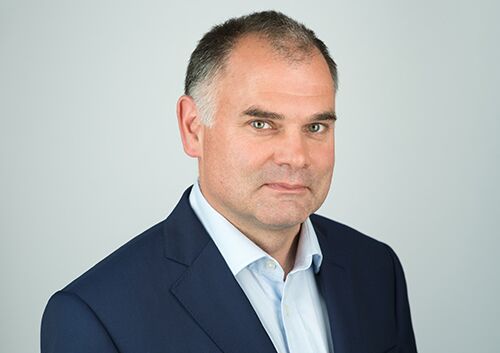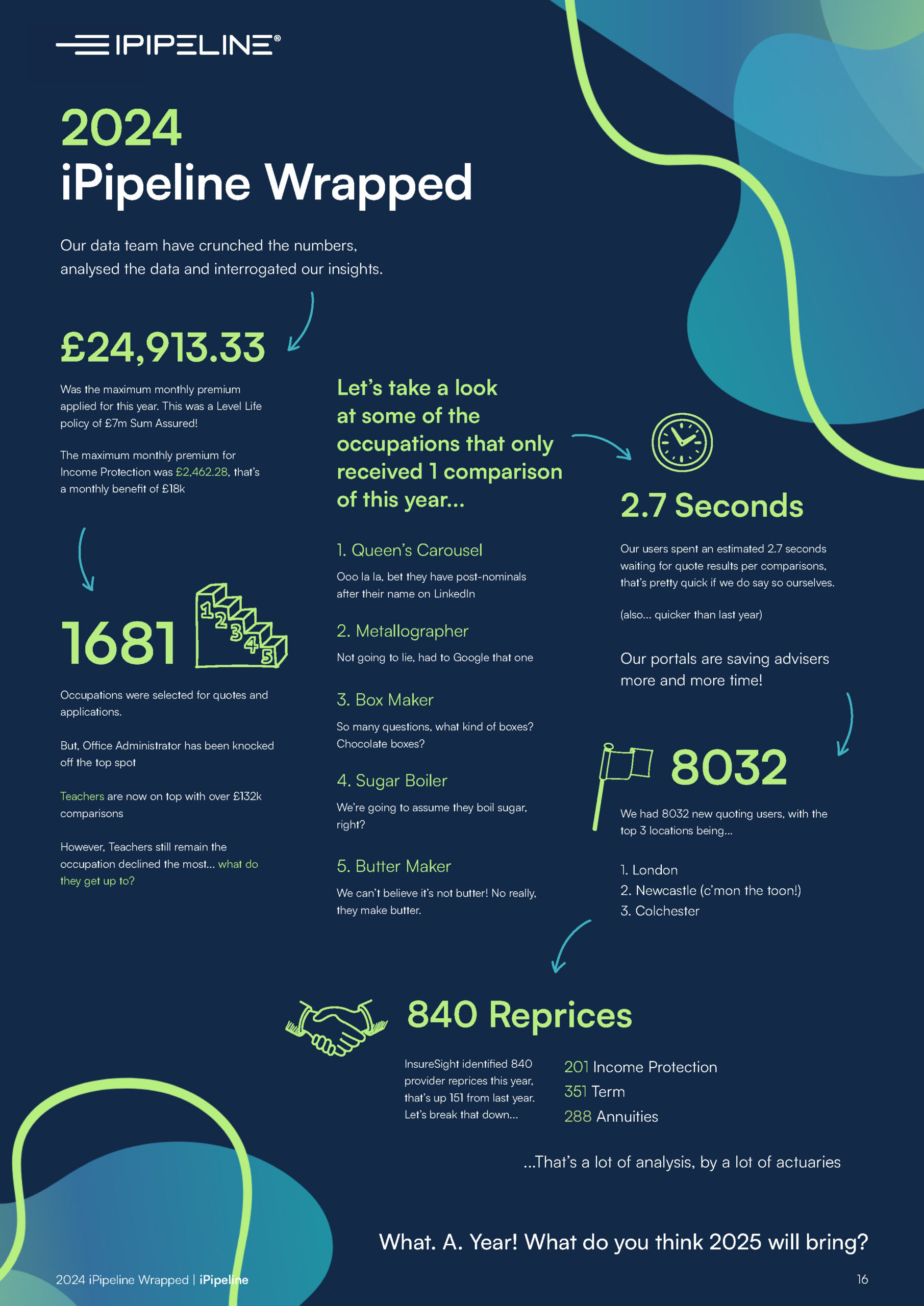SPONSORED BY:



2024 – What did we learn?

Our focus for 2024 was continued growth, innovation, and engagement to support our vision to secure people’s financial future and we’ve certainly seen the fruits of our labour.
In response to adviser feedback, we released an upgraded version of our PreQuo Lead Gen to help increase client engagement and boost protection opportunity generation.Quoted by David Mead, founder of Future Proof, as being “a great evolution of the product”, we are confident that through our data and predictive analytics information, this new UI and mobile experience that seamlessly integrates with a firm’s own website and branding, offers greater innovation and a more interactive experience. We need to help advisers engage people in protection. We know that technology like PreQuo can play an important role.
We’ve also continued the growth trajectory with new partnerships and transformation projects. This summer we announced our partnership with NTT Data powering our reach into Europe, building the provider engine of tomorrow in SSG Digital. In the UK, our partnerships with OneFamily and (pending timing of press release) most recently the re-platforming of Beagle Street’s D2C protection proposition and migration of its 212,000 customers onto OneFamily’s SSG Digital platform again showing the importance of solid technology foundations, especially for ambitious market challengers.
But these projects are only a reality because of our people – the talented teams that sit behind them. While we may not have walked away with any winners at November’s key industry events, we are thrilled to have received nominations in the ‘Insurtech of the Year’ and ‘Outstanding New Technology Offering’ (Cover Excellence awards) and Innovation Award (Protection Review awards) categories. Our congratulations also go to Kate Weller, shortlisted in the ‘Unsung Hero’ award category and Zoe Mears for the ‘Young Achiever’ award. Not forgetting Stephanie Hydon and Paul Yates’ parts in the panel sessions at the latter event.
2025 will be a big year at iPipeline. We will continue in our mission to dramatically improve the planning, selling and services of financial products. And we’ll continue to learn about our customers and understand how we can reach new segments, not forgetting DEI (Diversity, Equity and Inclusion) as an opportunity to get more people covered. In fact, key take aways from this year’s Protection Review conference were around the products consumers want and the different ways they want to access and engage with them as well as the challenges we will have of engaging with and servicing the new generation post-GenZ, Generation Alpha, who take on a new ‘soft life’ approach to life.
Finally, a mention of the forthcoming FCA study on protection and what it holds for the market. It’s a topic we can’t avoid and we each have an opinion on. Do take a read of the views within this edition, including the article by Neil McCarthy, Protection Distributors Group. All great educational reading.
Written by:
Why protection perfection does not exist

What is perfection?
At times in life, it can seem to be more of a quest than a question. With the seemingly endless amount of time we can all spend (or waste) on social media, you don’t have to look too far before you find a version of perfect. It could be an influencer sharing their perfect lifestyle. It could be a lifestyle coach sharing the perfect routine for high-performing individuals – a routine which usually seems to involve ice baths and endless amounts of self-reflection.
The reality is perfection is a concept that is almost always not based in reality.
In almost every aspect of our lives whether we seek perfection or not, we must accept compromise. From relationships to homes, compromise is what the world is built upon. When compromise breaks down, so do relationships. So do partnerships.
A Thought-Provoking Challenge
Our own Stephanie Hydon recently presented the excellent Protection Review – to challenge the concept of perfection vs pragmatism within the protection market, and whether a perfectionist approach was the enemy of growth. It was a thought-provoking topic, one which simply demanded me to sit down and write the perfect article to accompany it. This alone is my 20th separate attempt (**jokes**).
Complex Product Design
So, I began by thinking about all the ways that we have strived for protection, at the expense of progress or perhaps evolution. The first that immediately springs to mind is in product design. There is a very live debate within the market on whether products themselves are too complex, almost too comprehensive (or perfect?)– which in turn reduces the level of adviser understanding and confidence – and often lengthens the advice and application process.
In my view, there is some truth here – but as with almost everything, the answer isn’t binary. Yes, products are complex, yes many advisers would largely welcome a simpler approach to product design and yes, in places the cover products deliver might be beyond consumer expectations, but to an extent this comes as a result of the complex nature of our customer needs and desire/need to tailor solutions that fit perfectly.
The next challenge is on premiums, or the actual cost of cover.
The UK is probably the most price competitive protection market in the world. A race to the bottom on premiums which doesn’t at present show any sign of stopping.
But is this race for the ‘perfect’ price the right thing to drive market growth? Or is it hampering development in other areas and suffocating product and process simplification and other innovation? That’s a genuine and live debate.
Collaboration for Growth
Finally, and perhaps most pertinently, I wanted to view the topic of perfection when related to how we, as a market, collaborate with one another to achieve the greater good – growth and more people with secure financial futures.
What is clear is that despite best intentions and a huge amount of passion and massive engagement across all sectors, protection has refused to grow as we would like. There is no shortage of new initiatives, all in their own way designed to help tackle this status quo, but as yet no
silver bullet.
But do we collaborate in the way we should?
Do we connect initiatives to deliver maximum impact?
Are we as aligned as we could be to ensure that all ambitious programmes and developments are complimentary and not contradictory?
That’s a question that no one person can answer.
Written by:
How Critical Illness Cover Gave Us Time and Choices

In this case study, we explore how protection products can make a real tangible difference to families like Beth and Pete’s. By discussing their journey, we can highlight the crucial role these products can play in your clients lives during challenging times.
Beth’s Story
My husband Pete was diagnosed with a rare form of terminal lung cancer in his mid-30s.
Pete was a young, fit, healthy man. As a thirty-something marathon runner, his persistent cough, chest infections, and pneumonia weren’t thought of as anything serious by doctors. It took us two years to get him diagnosed because he was so young and didn’t smoke.
Lung cancer wasn’t a thing, and it took us going private to get him diagnosed.
Pete worked in the insurance industry and was very risk averse. We had arranged life insurance and critical illness policies after moving house and having our second child. Pete took financial advice, which helped him understand the best policies for our family. He had the understanding and the desire to get it but didn’t really know how much or for how long.
It turns out this advice would support a life-changing time for our family, as Pete was later diagnosed with stage four lung cancer and given two years to live. I was just an informed party rather than a decision maker.
He decided it was the right thing to do and thank God we did.
“Critical Illness Cover made a significant difference in our final years together.”
Paying For Memories, Not Mortgages
Critical illness and life insurance policies are often sold on the fact that the money can be used to pay off a mortgage. But this wasn’t how we used it.
Instead, we made the best of the life we had left together. It paid for an extension, and we had family holidays to Disneyland and Lapland. I absolutely took the brief of, go make memories.
The payment also gave us more options about healthcare and work. One of the major things was that we could go private. Once you have stage four lung cancer, your options on the NHS are quite limited. When you go private, it’s a night and day experience. You have access to all of the drugs, and it’s your choice through discussions about what you will go on and what treatment you’ll have.
It also meant I had the freedom to take time off to be with Pete – appointments, hospital stays, sitting with him while he had treatment, and spending time together without worrying about going back to work.
If you’re in a situation whereby you’re financially dependent on that salary, that must be a level of pressure that I think would have broken me. It was enough to look after Pete, to advocate for what he needed and to look after the kids.
Critical Illness Cover
I describe myself as the “biggest advocate” for Critical Illness Cover now, paying £100 a month for my policy. My experience has changed my mindset, and I count myself lucky if I never have to claim on my policy.
Generally, financial advice is angled to paying off the mortgage. We don’t talk about the actual impact on your life. It’s absolutely all about making it real. If you just keep it in money and mortgage and outgoings, it’s a really difficult conversation to land. But if you’re bringing in the emotions and what that can mean and trying to paint a picture of what that impact can have, people can take themselves there and actually understand what it is.
Listen to my full interview on episode 17 of the Just Covered podcast or watch Pete and I talk about our story.
Pete died just after his 40th birthday.
His policies have meant that I can take the time
I need to grieve and be with our two children.
I recommend that advisers talk to their clients not just about what cover can do in the short to medium-term, but the long-term impact it can have too. There’s also for the rest of forever. I’ve lost half a household income. If you had no cover, you’ll be at your lowest financial ebb because you will have used up all of your resources to get you to that point… You have that pressure on you to do something about it when you’re just in the most vulnerable place you’ve ever been in.
“I encourage advisers to be real with their clients about the emotions of a situation like mine and Pete’s.”
Legal & General Assurance Society Limited.
Registered in England and Wales No. 00166055.
Registered office: One Coleman Street, London EC2R 5AA.
We are authorised by the Prudential Regulation Authority and regulated by the Financial Conduct Authority and the Prudential Regulation Authority.
Why the FCA consultation paper is an opportunity, not something to fear.

At the time of writing, an FCA review of the Protection market will be underway, with larger firms already visited and analysis – or at least data requested and collection underway. From an advisory firm perspective, you will have your own view if it’s an opportunity or threat.
In case you aren’t aware, I’m referring to MS24: Market Study into the Distribution of Pure Protection Products to Retail Consumers, published back in August 2024. This specific study seeks to understand whether the market is functioning well and whether consumers are receiving good outcomes.
What is MS24?
Adviser firms will have come to terms within their own Consumer Duty approach in how they understand and evidence that the desired outcomes relating to:
- Products and services
- Price and value
- Consumer understanding
- Consumer support
…are being met and embedded within every stage of the customer journey.
With these specific points required under the far: wider-reaching Consumer Duty, advisers (and the broader distribution partners and manufacturers) may have been a little surprised about the specific market study in pure protection products.
The FCA is reviewing whether the market is functioning well and delivering good outcomes for consumers.
Key focus areas of the FCA Study
This “deep dive” into the Protection market is the first time to the PDGs knowledge that any regulator has attempted this, separating it from General Insurance. Whilst the FCA have said they are starting the market study with “an open mind as to whether we find evidence of harm,” they also point out:
We have seen indications that this may not be the case across the pure protection market and we will act if we find the market is not working well enough.
The FCA have identified areas where the market may not be functioning well and competition not working effectively in the interests of consumers.
Broadly they have identified:
- The design of commission arrangements may not always support delivery of fair value.
- Some pure protection products may not provide fair value to customers.
- Competitive pressure may be weakening due to the recent exit of several insurers.
Are the FCA concerned about indemnity commission in principle as a way of manufacturers paying distributors? I personally don’t think so. Does evidence from Australia and the Netherlands suggest that significantly amending commission structures has a massive negative impact on consumers’ protection levels? – Yes.
Often the disparity between commission rates impacts the insurer margin, not the customers monthly premium. Commission terms are often a factor of distributor business quality and volume. Where the underlying premium rate for the customer is increased using “loaded premiums”, demonstrating fair value becomes a challenge.
Delivering good outcomes for consumers
With respect to the FCAs comment of routinely switching products to earn additional commission, distributors have a great opportunity to state their processes. Re-broking to improve the level of cover, reflect clients’ changing circumstances, or take advantage of improved market rates should be encouraged to deliver good consumer outcomes, with the improvements clearly recorded. Insurer and distributor data will identify behaviours that don’t add any consumer value and could be controlled by insurers via agency management.
The Guaranteed Over 50s plan will come under scrutiny, particularly where the benefit paid is less than the premiums that have been paid over the policy term.
There is an additional challenge to ensure the product structure and pricing delivers value, whilst positioning the advantages that not requiring medical evidence brings. Advisers who recommend these products to clients who would not get cover if underwritten should position the value they provide.
There have been insurer exits to the market recently, and certainly the PDG would like to see more insurers competing for business and delivering innovative new solutions, but in the core markets of Life, CI and IP how many insurers are needed? Data collected from distributors will identify how many insurers are used from both whole of market and limited panels across these product areas.
Hopefully advisers reading this will agree that the UK protection market is broadly functioning well for UK consumers and delivering good outcomes.
According to the ABI the total payout was £7.34bn in 2023, significantly contributing to personal wellbeing, financial resilience and the general economy.
Clarity for All
This is a study those involved with the protection market should embrace.
A consequence of the study may be improved transparency in the sales process in terms of consumer understanding of the difference between buying with advice versus through a non-advised sales process.
Feedback from distributors would help to understand whether insurers, upon whose underwriting we depend, do enough to help vulnerable customers and customers with pre-existing complex medical needs.
Good advisers have always embraced the principle of delivering good outcomes for their customers. A deep dive into the protection market may unearth a few areas that need to be improved or stopped – but will also reinforce the good that is done in helping consumers purchase more protection and building financial resilience. We don’t want over regulation, but this level of scrutiny may identify where controls can be better utilised.
The Protection Distributors Group is formed of UK based protection advisers, specialising in the provision of protection advice to, and arranging of protection policies for consumers, both personal and corporate. We are not a conventional trade body, in that our clearly stated purpose is specifically to improve what our market does for its customers.
More information and the current membership can be found here: Home – Protection Distributors Group.
If you want information about joining the PDG contact us via our email: [email protected]
Written by:
The future of protection – A conversation with Peter Hamilton and Paul Yates

The protection market has possibly never been under greater scrutiny. The FCA’s forthcoming market study is, understandably, attracting huge attention and focus.
Paul Yates spoke to Zurich’s Peter Hamilton to reflect on this, amongst the market’s other hot talking points.
Paul: Looking ahead to the next 12 months, we’re hopeful about the future of protection, but there are uncertainties.
The FCA’s review of the market could have a significant impact, but what’s your take on how it will influence the profile of protection?
Peter: It depends on who you’re talking about.
For customers, I don’t think the review will make much difference. They’re unlikely to be aware of what’s happening—unless it’s something that hits the national press, which is unlikely. The real opportunity might be with advisers who typically don’t focus on protection.
My fear is that some might be put off by the headlines of an investigation into the market, thinking it’s a reason not to get involved. The key here will be how we, as an industry, present the review.
I think we need to welcome it, as it’s an area that has been largely unaddressed. The review is a rare opportunity to address challenges we might otherwise shy away from due to competition laws.
Paul: You raise an interesting point. The protection market feels a bit like a closed system at times, doesn’t it?
It’s heavily focused on two channels—’bolt-on’ sales alongside mortgages or via IFAs conducting fuller financial reviews. Then, there’s the smaller number of advisers, but important segment of professional protection writers. Do you think the market is working as it should?
Peter: When I started in this industry over 40 years ago, the numbers of people involved in selling protection were vast.
The reduction in advisers hasn’t led to a proportional decrease in sales, which speaks to the resilience of those firms that have stayed. But yes, if you compare protection to other markets—like motor insurance, where 63% is sold direct—it highlights how different protection is. People are
just not compelled to buy life insurance the way they are with car insurance. It’s the nature of the product. But there’s an opportunity here for advisers to do more to educate people about why protection is so vital.
Paul: It’s definitely a product that doesn’t come with the same urgency as something like pet insurance, where people are more willing to talk about it. Do you think that’s part of the issue? People don’t want to talk about death or illness.
Peter: Yes, it’s a lot easier to talk about pet insurance because people love their pets and the topic itself is happier.
You don’t hear people casually talking about the financial impact of being unable to work due to illness. But the reality is, if people understood the financial implications—if they truly grasped how much protection could mean for their families—they’d view it differently.
Paul: But what about the long-term nature of protection products Peter?
In today’s world, where consumers are more short-term oriented, is it harder to get them to commit to something that lasts 10, 15, or even 25 years?
Peter: Paul, you’re spot on.
A younger generation’s financial horizon is typically one month to the next, so there’s a disconnect when they look at long-term protection products. But these products offer great value for consumers. In countries like Australia, they don’t offer the same kind of guaranteed long-term policies we have here. In fact, most places don’t offer such low premiums for such comprehensive cover.
We have a fantastic deal, and that’s something we need to make clearer to consumers.
Paul: Exactly, Peter.
It’s the nature of the product, but people just don’t engage with it regularly. Firms don’t always provide the kind of annual updates or reminders they should. It makes people forget about it until they need it.
Peter: That’s true, Paul.
I have policies with companies that I haven’t heard from in years. It’s not necessarily their fault, though—part of it’s on me for not updating my contact details. But insurers need to find better ways to keep their customers engaged and
remind them of the value they have. There’s a fear that if you remind customers too often, they’ll just cancel, but if they don’t understand the value, they’ll cancel anyway.
Paul: Let’s talk about the remuneration model.
You’ve seen the changes in other markets, like in Australia, where a drastic reduction in initial commission caused a massive drop in advisers. Could something similar happen here?
Peter: That’s a great point.
The Australian model definitely had some unintended consequences. When they cut initial commission, many advisers found it no longer made financial sense to sell protection. The result? A drastic drop in the number of advisers selling protection, and the market is now dominated by a handful of firms.
We need to be careful not to repeat that mistake here. The balance between initial and ongoing commission needs to be right, especially if we want to encourage annual reviews with clients.
Paul: So Peter, how do we get to those who are underserved?
We need to reach the younger generation, the self- employed, and renters. Right now, they’re often forgotten.
Peter: Yes, absolutely Paul.
Renters in particular is a tough group to reach. Many cancel their policies once their rental agreement ends because they don’t see the need to continue. There’s a big opportunity here, though, to create products that are flexible enough for them, products that can be carried across different living situations. The traditional mortgage-linked approach just doesn’t work for them.
Paul: What about the role of digital platforms?
With the rise of TikTok and Instagram, could social media be the answer to reaching these younger audiences?
Peter: It’s a fascinating challenge.
The younger generation isn’t engaging with traditional media like TV ads. They’re using platforms like TikTok, where they’re getting their information from influencers rather than traditional brands. The real opportunity is figuring out how to create a message that resonates with them.
Just putting life insurance on TikTok might not work. It’s all about the process—making the buying process easier and more accessible. If we can make protection something they think about early in life, and make it a regular part of the conversation, that’s when we can make a real difference.
Paul: It’s all about making protection relevant and accessible, in ways that speak to the way people live their lives now.
Peter: That’s spot on Paul.
And that’s something the industry needs to tackle. It’s not about reinventing the wheel, but about refining our approach to meet the demands of a changing market. Oh
As the conversation wrapped up, both Peter and Paul agreed that while the protection market faces challenges, the FCA’s review provides a vital opportunity to modernize and better serve customers.
The key lies in creating a more flexible, engaging, and accessible model that resonates with a broader audience, especially younger generations. With a shift in strategy, the future of protection insurance could, and perhaps should, be bright.
Written by:
Boosting Gen Z Income Protection – Adviser strategies to close the Protection Gap
Daren Boys, Protection Portfolio Distribution Director at Aviva, shares insights from Aviva research highlighting awareness of income protection and the opportunity that advisers have to help close the protection gap among younger generations.
New Aviva research highlights that over two-thirds (67%) of UK adults would struggle financially if they were unable to work due to ill health. This concern is even more pronounced among millennials aged 28-43, with 78% expressing financial vulnerability and indicating the critical need for income protection.
Despite these concerns, a significant majority (71%) of UK adults have never considered income protection. Among these, around one in five have never heard of the product, with this figure rising to a quarter among Gen Z.
Financial Coping Strategies
The research also sheds light on how people would manage financially if they were unable to work long-term. Just under half would rely on their savings, while slightly fewer would cut back on non-essential spending.
A third would opt for lower-cost brands to manage
their expenses.
Around two in five would seek financial support from other sources, such as borrowing from friends or family, relying on someone else to cover costs, or taking out a bank loan. Additionally, just under a third would depend on state benefits.
Barriers And Triggers To Purchase
The study reconfirmed two main barriers to purchasing income protection: perceived cost and lack of awareness. Over a quarter of respondents felt they couldn’t afford the product, while a similar number didn’t think they needed it. However, over a quarter indicated they might consider income protection in the future, and fewer than a third said they would never consider it.
Perhaps unsurprisingly, buying a house emerged as the top life event prompting individuals to consider income protection. In sharp contrast, however, fewer than one in ten would consider it when moving into a rental property, highlighting an opportunity to raise awareness about the importance of financial protection, regardless of home ownership status.
Interestingly, just under half of Gen Zs, who represent a high proportion of renters, said they might consider income protection as they get older.
This presents a key opportunity for advisers to engage with this demographic and grow their income protection portfolios.
Income Protection:
The most appealing product for Gen Zs
Aviva’s research found that income protection is the most appealing protection product for younger generations.
Almost a third of Gen Zs said they would actively consider it, with three-quarters showing some interest. Among those without income protection, three in four expressed a desire to learn more about it, indicating that barriers to entry are more about education and awareness than rejection or distrust.
Although Gen Zs are digital natives, the research highlighted the importance of human intervention to aid understanding and build trust.
This underscores the essential role advisers can play in raising awareness of income protection among this audience.
Conclusion And Adviser Recommendations
Income protection provides a much-needed safety net. Through the great work and focus across the industry via initiatives such as IPTF, we have seen income protection sales across the market rise.
Our research shows there is still yet more to be done to close that lack of awareness of how income protection can create financial resilience across wider customer segments.
So, there is a real opportunity for advisers to tap into this and speak to younger audiences about income protection. Many Gen Zs are currently renting, but they have an optimistic ambition to achieve key milestones in their future and are motivated to secure a stable future for themselves and their loved ones. This future-focused attitude can open the door to starting conversations about income protection now, rather than waiting until they reach traditional milestones like buying a house.
We can help advisers access valuable resources to support renting clients on Aviva’s Tenant Protection Hub or by reaching out to their local Aviva Protection Business Development Manager (BDM).
Find out more about Aviva Tenant Protection Hub
Aviva’s GEN Z Insight Research, January 2024
The research was conducted by Censuswide with 1,002 UK employees of working age (16-65) – (full time OR part time) who do not currently hold a personal income protection policy (minimum of 250 Gen Z respondents) between 09.09.2024 – 13.09.2024. Censuswide abide by and employ members of the Market Research Society which is based on the ESOMAR principles and are members of The British Polling Council.
Written by:
Digital marketing for financial advisers.

Success starts with a plan.
“For many small businesses, financial advisers included, digital marketing is a topic that doesn’t create hope but fear. Fear that is often driven by the unknown.”
Of a world that they think they don’t understand. It’ not hard to figure out why, just like financial services, digital can, at times, seem an impenetrable world of complex terms and definitions. It can seem like a web of acronyms. SEP, SEM, PPC, ABM (and the list goes on, even if the understanding doesn’t follow). But digital isn’t going away, it is only going to get more important as advisers look to engage with clients and prospects in new, different ways. So, for those who want to attract and keep their clients of tomorrow.
Getting digitally savvy is no longer a choice,
it’s a necessity.
Finding a start point
As with all successful business strategies, the best digital activity begins with a plan. As many digital tools, such as email and social channels are free to use, it can be tempting to get going without going through this discipline – but it is crucial to resist that temptation.
The best digital activity across businesses both big and small are built on robust plans. Plans which should take in at least the following topics.
Defining objectives
Any activity that is worth time and investment, whether that investment is financial or time, needs to have a clear set of defined goals. These goals define and set aspiration; they provide a benchmark for what success looks like.
These goals should be SMART (specific, measurable, achievable, relevant, time bound) and could take in many areas. It could be as simple as several leads created (so long as their source is trackable), or it could be increasing traffic through a website. The key with these goals is to initially keep them simple and to understand that the first goal may be to create a baseline to measure success against in the future. In addition to making goals SMART, you may find it helpful to break them down into 3 categories.
1. Strategic
What are your long-term objectives for digital marketing? For example, how important a role will it play in your success in 3 years’ time?
2. Tactical
More short-term focused and often easier to measure. For example, how many leads do you want to create from a specific activity or campaign?
3. Operational
These goals detail the practical steps you need to deliver your strategy. For example, onboarding a new marketing automation platform.
Who to target?
A key component of your plan should be a detailed target market – the groups of prospects and customers you want to target with your digital activity.
When considering who you want to target, both need and value should be front of your mind. Which sectors of the population have a real, compelling need for your advice, and which can you deliver the most value to. It helps to be as granular and detailed as possible. Effective targeting helps you align to a sector and speak to them directly.
For mortgage and protection advisers, it may be that your target markets include:
Unprotected mortgage holders
Mortgage customers who declined protection or protection advice first time around. They can be an opportunity for cross sell and to deliver more advice value.
Self-employed
A large proportion of the self employed are woefully under prepared in terms of financial protection. To target them directly, think about how your advice can access the right products, service and speak to them about the problems they face.
Families
This broad term doesn’t go far enough. Think about the stages that families go through, buying a home, having children, working into retirement. Also consider sociodemographic and whether they aid effective understanding and positioning.
Written by:
The value of using your superpowers when protecting.

The concept of superpowers often sparks visions of extraordinary abilities—whether it’s flying, super strength, or controlling the elements. In both fiction and theory, superpowers are most impactful when used to protect people.
When used correctly, superpowers can protect lives, protect families, give security and peace of mind.
Superman’s strength and speed allows him to save people from natural disasters, such as earthquakes or collapsing buildings, often rescuing hundreds in moments.
His commitment to shielding the vulnerable ensures a sense of security in a chaotic world. Without individuals like him stepping up, the consequences of such calamities could be catastrophic. As financial advisers you could argue there is also a responsibility to shield the vulnerable and help them avoid misfortunes for both them and their loved ones.
We are seeing almost half of customers (46% – Source: AMI Viewpoint survey) are now sourcing their own protection online without any advice. Often leading to inaccurate cover amounts, incorrect terms and at risk of being either under or over-insured. But the biggest concern is how frequently these policies lapse due to the customer not truly understanding why they made the purchase, or what the impact means if they cancel it.
In many circumstances, clients could be paying a higher premium by using price comparison sites which do not fully underwrite the policies, so the customer pays more due to the insurers risk taken. In my opinion the adviser community should be shouting about that in their marketing and communications.
While no one can lift skyscrapers or shoot lasers from their eyes, financial advisers and professionals possess unique skills and resources they can use to protect others.
Superpowers in this sense symbolise any exceptional ability that can be directed toward the greater good.
Additionally, protecting people often inspires unity and collective resilience.
Lastly, using superpowers to protect others establishes ethical boundaries, and how unchecked power can harm society, emphasising the importance of responsible and compassionate use of your abilities.
Technology also plays a pivotal role, and it doesn’t have to cost the earth either. Advisers don’t need to immediately invest thousands in lead generation campaigns to stimulate the next generation of protection customers.
iPipeline has recently launched a new, improved version of its ground-breaking PreQuo Lead Gen tool, designed to educate customers and convert them into qualified protection leads. The tool provides customers’ predictive instant feedback on potential cover amounts, duration and risks, along with an indicative premium from only providing straight forward information about their circumstances.
Also, check out iPipeline’s recent Digital Marketing for Financial Advisers webinar, which gives you some great insight, ideas and inspiration from iPipeline’s Marketing Director – Nick Jones.
When clients feel engaged and educated, they are more confident in their decisions and more satisfied with their chosen policies. This transparency fosters stronger client relationships. And having the security of knowing they are protected.
Written by:
The power of advice can be amplified through technology.

If you’re reading this article, and the current edition of iPipeline Quarterly, the chances are you will know a thing or two about us.
You may not know and appreciate the breadth of our solutions, that we provide technology and data right through the financial services value chain – from reinsurer to adviser. You may not know that our portals produce 50% of all advised protection business in the UK.
You may not even know that over 3 in 10 protection applications are made on our provider platform – SSG Digital.
So, with the shameless plug out the way, I would however, be surprised if you didn’t know what we stand for as an organisation.
At iPipeline, we have always been strong advocates of the need for consumers to secure their financial futures, through protection insurance, savings and investments and proper planning for retirement.
We have also always been huge advocates for financial advice. We know and understand the vital role that expert advisers play in making their clients lives better and more resilient through sound financial plans. Although that’s not to ignore the huge importance of the D2C sector, where crucial cover reaches sectors of the population who choose not to engage with advice. Choice for all is vital.
But the sad truth is that advice still reaches too few of the people who would like to access it. For many, the concept of financial advice is alien – either through a lack of logical access points (not everyone can expect to own a home and take out a mortgage) or because their level of personal assets and investments simply aren’t high enough for advisers to be able to engage with them. A minimum figure which is now typically in excess of £200,000 for many advisers.
The result?
A perilous situation where a larger and larger proportion of the population are ill-prepared financially for retirement, coinciding with the first generation for whom final salary schemes are no longer a thing. Equally, despite a population more commonly experiencing chronic health conditions, protection fails to gain a real foothold in society.
So, financial advice is at a crossroads and its future has been the topic of a huge debate in the industry as we consider how guided or targeted, simplified or automated advice might transform a market which is serving too few. We’ve watched with interest as this debate has played out in the press over recent months. It is clear that there is consensus – too few people have access to financial advice. But it is also clear that there are varying opinions about how we can tackle this status quo.
This debate matters as it will have a dramatic impact on the size and shape of the financial services market over the coming years and decades. This debate matters because the size of the financial services and advice markets will be directly linked to the long-term financial security of our nation. All of us do what we do to make a difference. To protect people. To make them prosperous.
So that paints the helicopter view of one of THE defining challenges of our times. How do we unlock the huge power and benefit of financial advice to the mass market?
What becomes clear when you ask this question is that there is no easy answer or quick fix. There are just 28,000 advisers in regulated advice firms in the UK, on average – each of those adviser serves just 127 clients. Advice is currently a supply constrained market.
We wanted to explore this concept in more detail – so we asked John Lappin (ex Money Marketing Editor) and our own Paul Yates to apply their wisdom, experience and analysis to explore just how we got here and how we can revolutionise the advice market for a different future. The resulting whitepaper is an insightful and essential read.
My word limit here means I simply don’t have the real estate to go into detail, but I suppose it goes without saying (as technologists) that we believe technology has a, if not the, crucial role to play. Both in building the foundations of a digital, efficient end-to-end market, and then making the most of those foundations with simple deployment of technology to power guided or simplified advice – for the customers of tomorrow.
So, if this article leaves you wanting to find out more – you can download our latest whitepaper Mind The Gap | Financial Advice. Unlocking the mass market
Written by:
Written by:
Latest Articles
Beyond insurance, behind the numbers
February 17, 2025
Paying claims is at the heart of what we do every day. Last year we paid out £1.18billion and settled 50,631 claims
Why the FCA consultation paper is an opportunity, not something to fear.
February 4, 2025
At the time of writing, an FCA review of the Protection market will be underway, with larger firms already visited and analysis – or at least data requested and collection underway.
Summer 2024 Introduction
February 11, 2025
In May, Swiss Re launched Term & Health Watch 2024, a report iPipeline have supported with our data for the last 5 years.
Term & Health Watch 2023
February 11, 2025
On 21 May, Swiss Re published Term & Health Watch 2024. This is an annual analysis of new individual protection sales in the UK from the previous year, based on sales data provided by protection insurers.
Understanding motivation: flipping the protection conversation
February 11, 2025
How well do we understand the value of critical-illness protection to customers?












